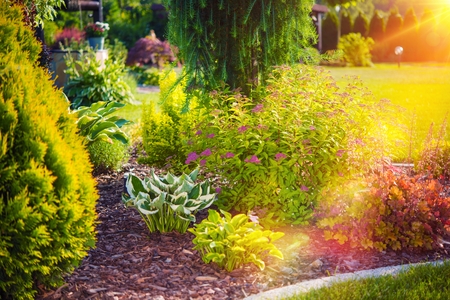1. Understanding Hardscaping in a Drought-Resistant Context
When it comes to designing a drought-resistant landscape, hardscaping plays a key role in reducing water use while still creating an attractive and functional outdoor space. Hardscaping refers to the non-living elements of your yard—think patios, walkways, gravel paths, retaining walls, decorative rocks, and more. These features not only add structure and style but also help conserve water by minimizing the need for thirsty grass or high-maintenance plants.
Why Hardscaping Matters in Dry Climates
In arid and semi-arid regions like much of the American Southwest, traditional lawns and lush gardens can be difficult—and expensive—to maintain due to limited rainfall. Hardscaping offers a smart alternative by replacing high-water-use areas with durable surfaces that require little to no irrigation. By incorporating hardscape elements strategically, homeowners can reduce their water bills, lower maintenance needs, and still enjoy a beautiful outdoor environment.
Benefits of Hardscaping for Water Conservation
| Hardscape Element | Water-Saving Benefit |
|---|---|
| Gravel or Decomposed Granite Paths | Replaces turf and allows rainwater to filter into the ground |
| Paver Patios | Eliminates the need for irrigated lawn space |
| Retaining Walls | Helps manage runoff and erosion in sloped yards |
| Dry Creek Beds | Mimics natural drainage while adding visual interest |
| Mulched Seating Areas | Reduces evaporation and keeps soil moist around plantings |
Sustainability Through Smart Design
Hardscaping isn’t just about aesthetics—it supports sustainable landscape design when used correctly. Permeable materials like gravel or open-joint pavers allow rainwater to soak into the soil rather than run off into storm drains. This helps recharge groundwater supplies and prevents erosion. Using local stone or recycled materials also reduces environmental impact while giving your yard a natural look that blends with the regions character.
Tip:
If you live in an area prone to drought, check with your local extension office or water agency for rebates on water-saving landscaping upgrades. Many communities offer incentives for replacing lawns with xeriscape-friendly features like hardscapes.
By understanding how hardscaping fits into a drought-resistant landscape, you can start planning a yard that’s both beautiful and built to thrive in dry conditions—all while saving water and supporting sustainability.
2. Choosing the Right Hardscape Materials
When designing a drought-resistant landscape, selecting the right hardscaping materials is just as important as choosing water-wise plants. The goal is to use materials that not only complement your yard’s aesthetics but also perform well in dry climates and require minimal upkeep. Below are some popular and effective options to consider for your low-water landscape.
Durable and Low-Maintenance Options
Dry environments demand materials that can handle heat, resist erosion, and stay attractive with little maintenance. Here are a few tried-and-true choices:
| Material | Benefits | Ideal Uses |
|---|---|---|
| Decomposed Granite | Natural look, good drainage, affordable | Pathways, patios, ground cover |
| Gravel | Excellent drainage, low cost, easy to install | Driveways, walkways, mulch alternative |
| Permeable Pavers | Allows water to seep through, reduces runoff | Driveways, patios, walkways |
| Recycled Concrete | Sustainable choice, durable, budget-friendly | Paving stones, retaining walls, garden borders |
Why Permeability Matters
In drought-prone areas, it’s crucial to keep as much rainwater on your property as possible. Permeable materials like gravel and permeable pavers help reduce runoff and promote groundwater recharge. These materials let rain soak into the soil instead of washing away, which is better for your plants and the environment.
Sustainability Meets Style
Using recycled or repurposed materials not only helps conserve resources but also adds unique character to your landscape. For example, broken concrete slabs—often called “urbanite”—can be creatively reused to build pathways or garden edging with a rustic flair.
Tip:
If you’re unsure which material suits your space best, think about how you’ll use the area. Heavy foot traffic? Choose something solid like pavers or decomposed granite. Decorative zone? Gravel may be all you need.
Quick Checklist for Material Selection:
- ✔️ Is it heat- and drought-tolerant?
- ✔️ Does it require little maintenance?
- ✔️ Does it allow for proper drainage?
- ✔️ Is it environmentally friendly or recycled?
- ✔️ Does it fit your design style?
Selecting the right hardscape materials sets the foundation for a beautiful and functional drought-tolerant yard that saves water and stands up to the elements.

3. Designing for Aesthetic and Functionality
Creating a drought-resistant landscape doesn’t mean you have to sacrifice style or comfort. By incorporating hardscaping elements like pathways, patios, and retaining walls, you can build an outdoor space that’s both beautiful and practical. The key is to design these features in a way that complements your drought-tolerant plants while maximizing usability.
Pathways That Guide and Define
Pathways help guide foot traffic and define different areas of your yard. Choose materials like decomposed granite, gravel, or flagstone—they’re low-maintenance and allow water to permeate the ground, which supports your eco-friendly goals. When designing paths, consider gentle curves instead of straight lines for a more natural feel. This not only enhances visual interest but also helps blend hardscape with surrounding plants.
Popular Pathway Materials for Drought-Resistant Landscapes
| Material | Benefits | Best Use |
|---|---|---|
| Decomposed Granite | Permeable, affordable, natural look | Main walkways or garden paths |
| Gravel | Easy to install, good drainage | Side paths or accent trails |
| Flagstone | Attractive, durable, non-slip surface | Main entry paths or patio borders |
Patios That Invite and Entertain
A well-placed patio can serve as an outdoor living room, perfect for relaxing or hosting guests. In a drought-tolerant yard, patios reduce the need for large grass areas and offer usable space year-round. Choose pavers or concrete slabs in earthy tones to blend with the natural surroundings. You can soften the look by planting drought-tolerant groundcovers like creeping thyme between stones.
Retaining Walls That Support and Style
If your property has slopes or uneven ground, retaining walls are a smart solution. They prevent erosion while adding structure and height variation to your landscape design. Build them with natural stone or concrete blocks for durability and a cohesive look with your other hardscape features. Use tiered retaining walls to create planting beds filled with native succulents or ornamental grasses.
Tips for Blending Hardscape with Plants:
- Select neutral-toned materials that complement plant colors.
- Add texture by mixing smooth stones with rough gravel.
- Create contrast by pairing bold structural plants (like agave) near clean-lined patios.
- Use mulch around hardscape edges to unify the design.
A thoughtful balance of hardscape and drought-tolerant greenery can turn any yard into a stylish, water-wise retreat. Focus on integrating functional elements that match your lifestyle while highlighting the natural beauty of low-water plants.
4. Integrating Hardscape with Native and Xeriscape Plants
Blending hardscape elements like stone paths, gravel patios, and retaining walls with native and xeriscape plants is a smart way to create a drought-resistant landscape that’s both beautiful and eco-friendly. This approach not only reduces your water usage but also supports local wildlife and adds serious curb appeal.
Why Native and Xeriscape Plants Matter
Native plants are naturally adapted to your region’s climate, soil, and rainfall patterns. Xeriscape plants, which are often drought-tolerant, require minimal irrigation once established. When paired with hardscape features, these plants help create a low-maintenance landscape that thrives without constant watering.
Smart Ways to Combine Hardscape and Plantings
Here are some creative ideas to help you seamlessly integrate hardscaping with native or xeriscape plantings:
- Gravel Mulch Beds: Use crushed granite or pea gravel as mulch around drought-tolerant shrubs and succulents to conserve moisture and suppress weeds.
- Paver Pathways with Groundcovers: Install paver walkways with gaps filled by hardy groundcovers like creeping thyme or blue star creeper for a soft, natural look.
- Raised Planters: Build raised beds using stone or concrete blocks and fill them with native perennials that attract pollinators like bees and butterflies.
- Boulders as Focal Points: Use large rocks or boulders among desert plants like agave or yucca for visual interest and structure.
Example Plant + Hardscape Combinations
| Hardscape Feature | Suggested Plants | Benefits |
|---|---|---|
| Gravel Patio | Lavender, Salvia, Penstemon | Aromatic blooms; attracts pollinators; low water use |
| Paver Walkway | Creeping Thyme, Dymondia | Tolerates foot traffic; softens hard lines; drought-tolerant |
| Boulder Accents | Agave, Red Yucca | Sculptural look; heat-tolerant; low maintenance |
| Retaining Wall Planters | Sedum, California Poppy | Adds color; controls erosion; supports local ecology |
Biodiversity Benefits
A well-balanced mix of hardscaping and native plantings doesn’t just save water—it also helps support local biodiversity. Native flowers provide nectar for hummingbirds and bees, while dense shrubs offer shelter for beneficial insects. Even small yards can become thriving ecosystems when designed thoughtfully.
Curb Appeal That Lasts All Year
The right combination of textures from stone, wood, and metal with the colors and forms of native plants creates a visually appealing yard that looks great in every season. Best of all, you’ll spend less time watering and more time enjoying your outdoor space.
5. Maintenance Tips for Long-Lasting Results
To keep your drought-resistant landscape looking great and functioning well, its important to take care of your hardscape elements. Even though hardscaping—like gravel paths, stone patios, retaining walls, or decorative boulders—requires less maintenance than plants, it still needs regular attention to stay in top shape, especially in dry climates.
Keep It Clean
Dust, dirt, and organic debris can build up on surfaces like pavers and gravel, especially during dry spells when wind picks up loose material. Use a broom or leaf blower regularly to clear off walkways and patios. For deeper cleaning, a light pressure wash once or twice a year can help prevent stains and moss buildup.
Check for Shifting or Settling
Drought conditions can cause the ground to contract and shift, which may lead to uneven surfaces or cracks in hardscaping. Keep an eye out for areas where stones or bricks are sinking or becoming uneven. Prompt repairs will help avoid safety hazards and more expensive fixes later.
Seal Surfaces When Needed
If you have concrete pavers or natural stone features, applying a sealant every few years can protect against weather damage and staining. This is especially helpful in high-sun areas where UV rays can cause fading over time.
Prevent Weed Growth
Even with proper installation, weeds can sometimes grow between pavers or through gravel. Use polymeric sand between pavers to help block weed growth. For gravel areas, consider laying down landscape fabric underneath the stones to reduce unwanted plant life.
Inspect Drainage Systems
Hardscaping should always be installed with good drainage in mind. Check that water is flowing away from structures and not pooling around walkways or patios. In drought-prone regions, unexpected rainfall events can still happen—and when they do, poor drainage can damage your landscape quickly.
Hardscape Maintenance Checklist
| Task | Frequency | Why It Matters |
|---|---|---|
| Sweep or blow off debris | Weekly/Bi-weekly | Keeps surfaces clean and reduces slip hazards |
| Inspect for cracks or shifts | Monthly | Catches small issues before they become big problems |
| Reapply sealant (if applicable) | Every 2–3 years | Protects materials from sun and water damage |
| Treat weeds between joints/gravel | As needed | Maintains a tidy appearance and prevents spread |
| Check drainage paths | Seasonally or after heavy rain | Avoids erosion and structural damage |
A little routine care goes a long way in extending the life of your hardscape features while keeping your drought-tolerant yard both functional and beautiful.


